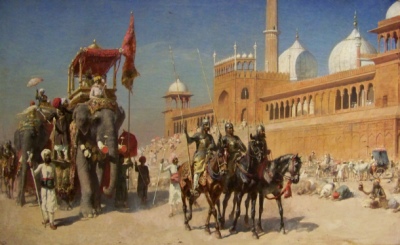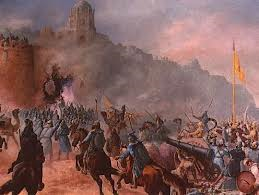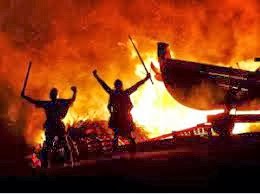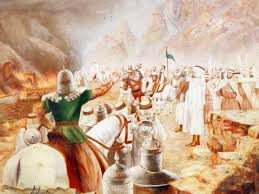 Qutayba ibn Muslim
Qutayba ibn Muslim was an
Arab commander of the
Umayyad Caliphate army who became governor of
Khurasan and distinguished himself in the
conquest of Transoxiana (Arabic:
Māwarāʾ al-Nahr) during the reign of
al-Walid I (705–715). A capable soldier and administrator, he consolidated Muslim rule in the area and expanded the Caliphate’s border to include most of Transoxiana. From 705 to ca. 710 he consolidated Muslim control over the native principalities of
Tokharistan and conquered the principality of
Bukhara, while in 710–712 he conquered
Khwarezm and completed the conquest of
Sogdiana with the capture of
Samarkand. The latter opened the road to the
Jaxartes valley, and during the last years of his life Qutayba led annual campaigns there, extending Muslim control up to the
Ferghana Valley.
To increase his strained manpower, Qutayba initiated the wide-scale levy of native Khurasani and Transoxianian soldiers who fought alongside the Arab Muslim troops. Following Walid’s death, Qutayba, insecure of his position under the new regime, rebelled but failed to secure the support of his army, and was defeated and killed. Most of his conquests in Transoxiana were lost in the years after his death; only in the 740s was the Muslim position restored to the line reached by Qutayba, and only after the
Battle of Talas in 751 did the region come solidly under Muslim control.
Origin and early life
Qutayba was born in 669 CE in
Basra, where his family was influential.
[1] His father, Muslim ibn ʿAmr, had enjoyed the favour of the
Umayyads, and fell at the
Battle of Maskin at the close of the
Second Islamic Civil War.
[2] Qutayba rose at first as the protege of
Anbasa ibn Sa’id, but was noticed by the powerful governor of
Iraq and the East,
al-Hajjaj ibn Yusuf, during the suppression of the revolt of
Abd al-Rahman ibn Muhammad ibn al-Ash’ath in 700/701. Under al-Hajjaj’s patronage, he took
Rayy from the rebel Umar ibn Abi’l-Salt in 701, and became the city’s governor.
[1][3]Then, in late 704 or early 705, Caliph
Abd al-Malik ibn Marwan appointed Qutayba as governor of
Khurasan. The choice of Qutayba, who hailed from the relatively weak Bahila tribe, was intended by al-Hajjaj to heal the
destructive feud between the South Arab or “Yemeni” (
Azd and
Rabi’ah) and North Arab (
Qaysi) tribal confederations in Khurasan by providing a governor who did not belong to either.
The Bahila were neutral between the two groups, but generally allied themselves to the Qays, thus furthering al-Hajjaj’s policy of emasculating Azdi power, which had been dominant in Khurasan during the governorship of
Yazid ibn al-Muhallab. Furthermore, as Qutayba lacked a strong tribal base of his own, he could be expected to remain firmly attached to his patron.
[1][4][5][6] Qutayba would spend the next ten years of his life in
Central Asia, consolidating and expanding Muslim rule there. In this endeavour, both his military and diplomatic and organisational abilities came him in good stead; most importantly, he was able to enlist the support of the local Iranian population and the powerful
dihqan (the Iranian “
gentry“) class.
[1][7]Conquests in Central Asia
The Arabs had reached Central Asia in the decade after their decisive victory in the
Battle of Nihavend in 642, when they
completed their conquest of the former
Sassanid Empire by seizing
Sistan and Khurasan.
[8] The first Arab attacks across the
Oxus ranged as far as Shash (
Tashkent) and
Khwarizm, but they were little more than raids aiming at seizing booty and extracting tribute, and were interrupted by the inter-tribal warfare that broke out in Khurasan during the
Second Islamic Civil War (683–692). Subsequent governors, most notably
Sa’id ibn Uthman and
al-Muhallab ibn Abi Suffrah, made attempts to conquer territory across the river, but they failed.
[9] The native princes, for their part, tried to exploit the Arabs’ rivalries, and with the aid of the Arab renegade
Musa ibn Abdallah ibn Khazim, who in 689 seized the fortress of
Tirmidh for his own domain, they managed to eject the Arabs from their holdings.
[10] Nevertheless, the Transoxianian princes remained riven by their own feuds, and failed to unite in the face of the Arab conquest, a fact which would be suitably exploited by Qutayba after 705.
[11]Conquest of Tokharistan and Bukhara
The first task which Qutayba set himself was the suppression of the rebellion in Lower
Tokharistan, which was accomplished swiftly with the reconquest of
Balkh. Qutayba then secured the submission of the local princes in the upper
Oxus valley, most notably of Tish, king of al-Saghaniyan, who invited Qutayba to aid him in his dispute with the ruler of nearby Akharun (or Akhrun) and Shuman, in the northern mountainous districts of Tokharistan. After extensive negotiations led by Sulaym the Persian, the
tarkhan Nizak, ruler of the
Hephthalite principality of
Badghis, surrendered to Qutayba, and pledged to accompany him in his expeditions.
[1][12][13]
In 706–709, Qutayba occupied himself with the long and bloody conquest of
Sogdia. The Sogdians were at the time divided by civil war in which
Bukhara had been seized by the ruler of nearby
Wardana, the
Wardan Khudah, while another local magnate,
Khunuk Khudah, had declared himself king of Bukhara (
Bukhar Khudah). Taking advantage of the conflict, Qutayba was able to easily capture the city of
Baykand after a two-month siege. He left a small garrison there and departed, but the inhabitants launched a revolt soon after. The Arab army then turned back and proceeded to sack the city. The men of fighting age were executed, the women and children sold off as slaves, and enormous booty amassed, especially in armour and weapons, which equipped the Arab army.
[1][14][15] The brutal punishment meted out to Baykand shocked the region: the Sogdians patched up their quarrels and the Sogdian princes of
Kish and
Nasaf united behind the
Wardan Khudah. Arab accounts mention the participation of
Turgesh troops as well, but this is probably an anachronism.
In the campaign of 707, Qutayba was able to capture two outlying towns, Tumuskath and Ramithana, before he was threatened in his rear by the allied Sogdian army. Qutayba avoided a battle, and engaged in negotiations to gain time, before executing a rapid retreat to safety through the
Iron Gate to beyond the Oxus, crossing the river at Tirmidh. The campaign of 708 was also a failure, which drew the ire of al-Hajjaj.
[16][17] For 709, al-Hajjaj drew up a new plan for his subordinate: the Arabs launched a direct attack on Bukhara, which caught the alliance—possibly weakened by the death of its leader, the
Wardan Khudah—by surprise. The city was taken by storm, a tribute of 200,000
dirhams imposed, and an Arab garrison installed. In its direct aftermath, Tarkhun, the ruler of
Samarkand sent envoys to Qutayba and became a tributary vassal to the Caliphate.
[1][




















